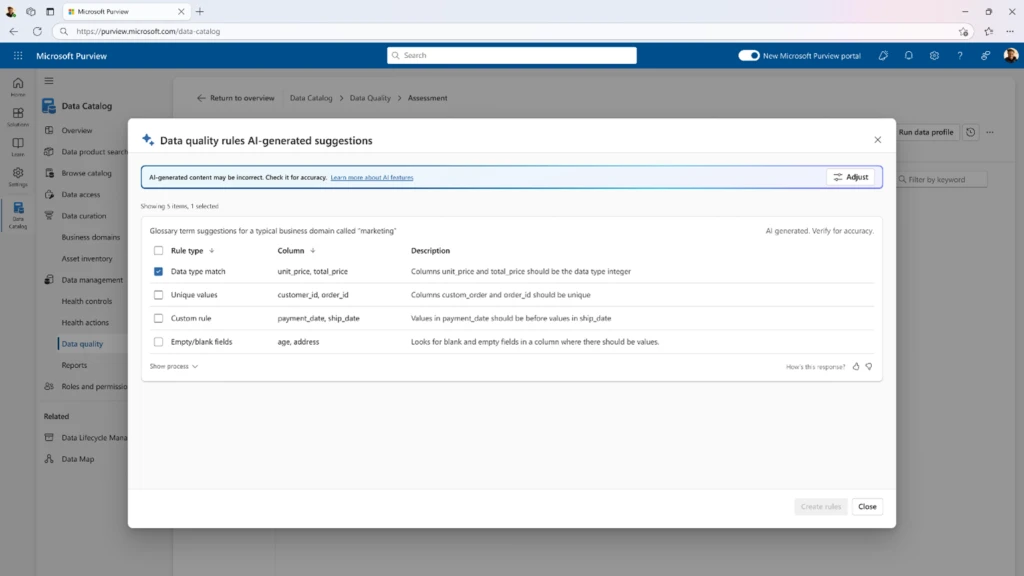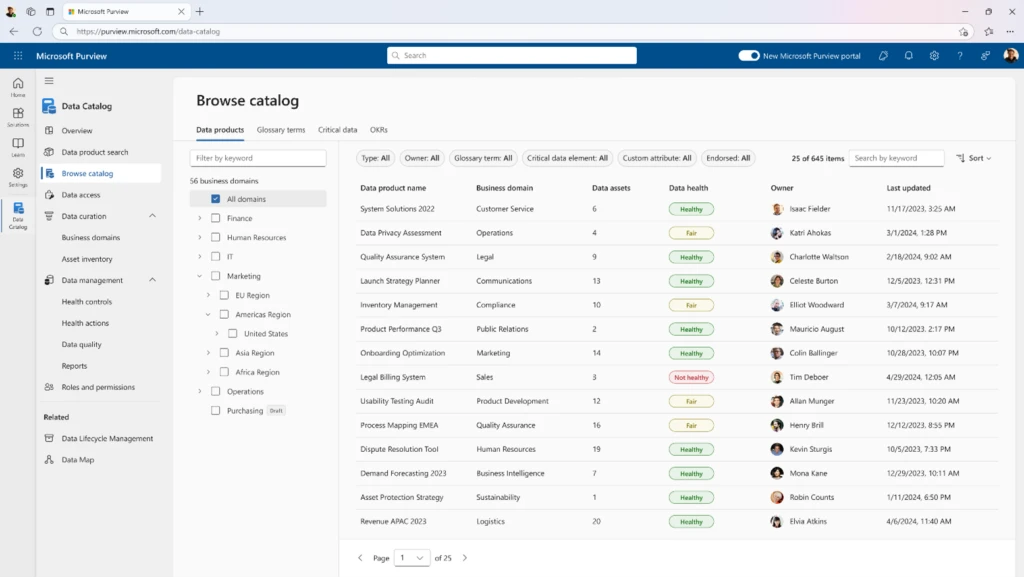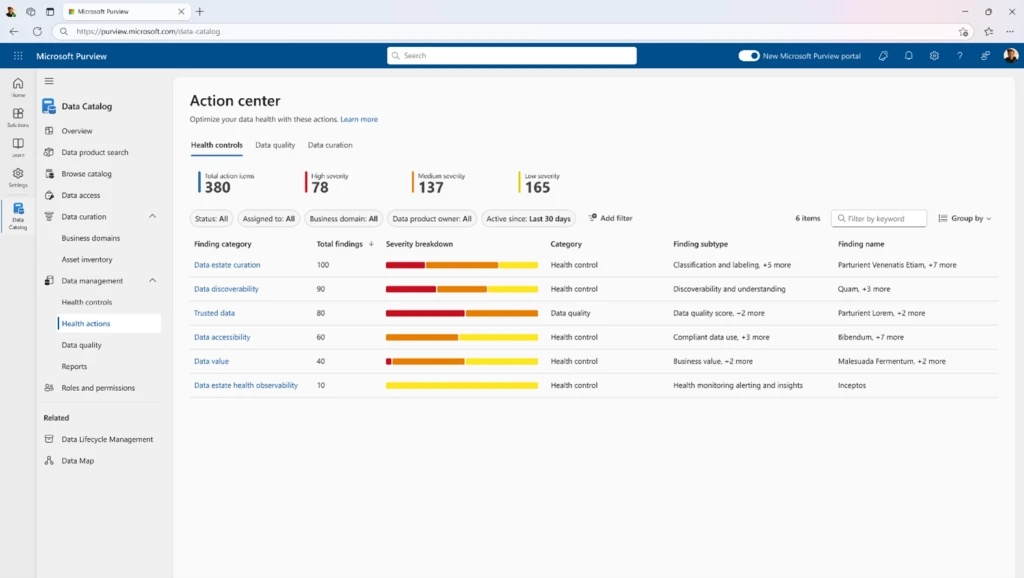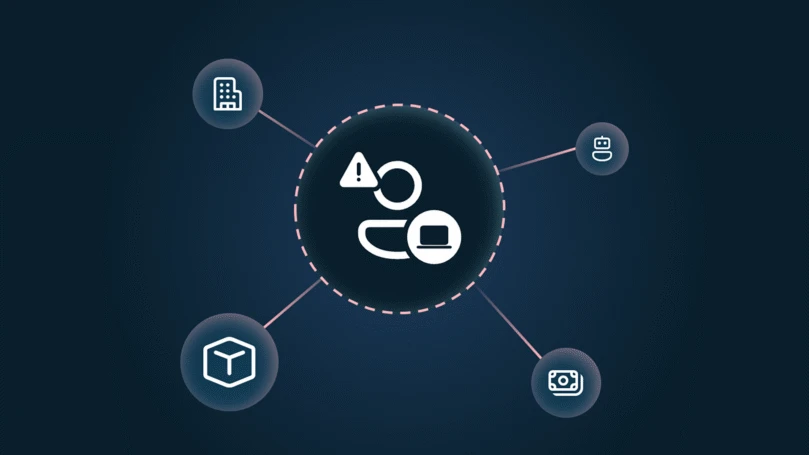We are excited to announce that the new Microsoft Purview Data Governance solution will be generally available beginning September 1, 2024. This experience is designed to help today’s data leaders solve their key governance and security challenges in an AI-powered, business-friendly, and unified solution. Since the service launch in early April 2024, usage has skyrocketed by more than 400%, with more than 1,500 commercial entities actively participating in data governance activities.
We are also excited to announce new innovations including an embedded Copilot in Microsoft Purview experience for data governance, deeper integrations with Microsoft Fabric, and broadening our partner network to help organizations confidently activate their data estate. In this post, we will highlight the growing challenges facing today’s data landscape and explore how Microsoft Purview Data Governance is helping customers establish a federated data-driven culture.
Microsoft Purview
Secure and govern data across your data estate while reducing risk and meeting compliance requirements.

Security and governance have become a team sport
In today’s world, the sophistication of cyberattacks, increasing regulations, an ever-expanding data estate, and business demand for insights are converging. This convergence pressurizes business leaders to adopt a unified strategy to confidently ensure AI readiness. Microsoft Purview is a comprehensive set of solutions that can help organizations secure, govern, and manage their data, wherever it lives. The unification of data security and governance capabilities in Microsoft Purview reflects our belief that our customers need a simpler approach to data. Microsoft Purview’s modern data governance solution addresses the challenges of the AI era with a business-friendly solution that empowers organizations to confidently democratize their data.
Governing data has been easier said than done
The practice of data governance is not just about technology. It starts with people and processes. Without a clear vision, strategy, and roadmap, organizations often struggle to align stakeholders, define roles, and communicate the benefits of data governance across the organization. This can result in low adoption and resistance to change. Data leaders encounter four primary challenges when implementing governance solutions:
- Fragmentation—Organizations find themselves using multiple tools to govern data. This can generate blind spots and lead to difficulties maintaining consistent data quality, security, and compliance.
- Labor-intensive tasks—Processes such as data classification, metadata management, and compliance reporting can be manual and time consuming.
- Centralized governance—A centralized approach stifles innovation and leads to shadow business intelligence where business units—often sales and marketing teams—resort to their own unauthorized tools.
- Technical interfaces—A poor user experience for business units can block their participation, leaving the practice of data governance centralized around IT.
Microsoft Purview Data Governance: a solution for the era of AI
About a decade ago, Microsoft’s Senior Leadership team, led by Chief Executive Officer Satya Nadella, asked a team of senior leaders, “Do we know where all of our data lives?” The question was difficult to answer. Like many organizations, our data was kept in silos, contributing to a lack of visibility and governance. This realization created an urgency for Microsoft to solve this problem in a way that could help our own business and our customers. We needed to streamline data visibility, management and access.
The biggest cultural change was the shift from a centralized approach to a federated governance structure with central guidance, training, and policies. This allowed individual business units to manage their own data quality while staying in sync with the main data office to maintain policy efficacy. This federated approach combined with the right technology tilts the scale in favor of the business, enabling every user to leverage high quality, trusted data. The re-imagined solution is grounded in years of applied learning and proven practices from navigating our own data transformation journey. Our vision for the new data governance solution is based on the following design principles:
AI-powered—To eliminate the drudgery of tasks surrounding manual classification and tagging of data, AI has been infused at every layer of the experience to help automate manual tasks and accelerate data curation, data management, and data discovery. For example, data stewards can now generate data quality rules automatically, saving hours of manual work. Data consumers can quickly find data products by specifying the data they are looking for in their natural language. With the power of AI, you can automate tasks like assigning business domains, providing glossary terms, and setting data quality rules and objectives and key results (OKRs) to make your data easily discoverable by the line of business users.

Figure 1. AI-powered data discovery in Microsoft Purview Data Governance.
Business-friendly—Designed with the user in mind, the new experience supports multiple functions across an organization with clear role definitions. The Data Catalog is an enterprise repository to help data stewards (people responsible for data governance) and data owners (people handling day-to-day maintenance of data) curate assets and enable responsible democratization of data. Within the experience, the data health capability was purpose-built for the data office to ensure data quality, alignment with industry standards (for example, Cloud Data Management Capabilities framework), and built-in reports to assess the health of the governance practice across the organization. For example, customers can easily define and organize data with business domains (such as finance and claims) and set OKRs to link business objectives to the Data Catalog.

Figure 2. Business-friendly browsing experience in the Data Catalog.
Unified—The unified experience reduces the need for fragmented point solutions. The integrated Microsoft Purview portal provides a centralized solution for data classification, labeling, lineage, audit logging, and management across a variety of platforms, including the built-in integration with Microsoft Fabric to ensure a best-in-class governance experience as you bring your data into the era of AI. The new experience also offers comprehensive data governance capabilities such as the extraction of metadata, scanning, and data quality across additional sources including SQL, ADLS, Synapse Analytics, and Azure Databricks, as well as third-party sources such as Snowflake. This streamlines the process, saving both time and the expense of integrating disparate solutions. Additionally, the new solution enables visibility across the health of your data assets, providing insights into curated data in your catalog, classification status, and sensitivity labels. Lastly, the solution includes built-in workflow capabilities to help you efficiently assign action owners to improve your governance posture.

Figure 3. Built-in workflows to improve governance posture.
“Embracing Microsoft Purview Data Governance has been a game-changer for Vanderlande. As a preview customer over the past 18 months, we’ve witnessed Microsoft Purview’s remarkable growth and the eagerness of Microsoft to bring a state-of-the-art governance solution to the market. Based on the general availability, we will start the implementation of these capabilities across our global organization.”
—Geert-Jan Verdonk, Data Governance Lead, Vanderlande (a Toyota automated logistics company)
New capabilities coming with general availability
Copilot embedded experience in Microsoft Purview (Preview)—We are introducing Copilot capabilities within the Data Governance experience to guide customers in getting started with the solution. This experience will recommend proven best practices to create an enterprise catalog, helping data professionals quickly discover, curate, and manage their data.
Deeper Microsoft Fabric integration (Preview)—As part of our tight integration with Microsoft Fabric, we are excited to announce the ability to build your own custom reports out of Fabric data. In addition, the data quality feature will now support any Microsoft Fabric source, whether it is mirrored or shortcut. If a source is supported by Fabric, Microsoft Purview can now scan it and use it as part of its data quality rules.
Broadening our partner network—As we announced in March 2024, a modern data governance solution integrates across your digital estate. We are excited to announce two more partners to our ecosystem: ER Studio (an Idera company) for data modeling and RELTIO for master data management. Additionally, CluedIn, Profisee, Semarchy, and Solidatus have their integrations live in Azure Marketplace today.
Try it today
Please log on to the Microsoft Purview portal and give the data governance experience within the “Data Catalog” icon a try. If you want to learn more, please access the following resources:
- Microsoft Purview Data Governance learning docs.
- Webinar: Fabric + Purview webinar—The CDO Dilemma.
- Visit the Microsoft Purview Data Governance website.
- Visit us at the CDOIQ Symposium at MIT in Massachusetts from July 16 to18, 2024.
- Blog: Modern Data Governance for the era of AI.
Learn more
To learn more about Microsoft Security solutions, visit our website. Bookmark the Security blog to keep up with our expert coverage on security matters. Also, follow us on LinkedIn (Microsoft Security) and X (@MSFTSecurity) for the latest news and updates on cybersecurity.








